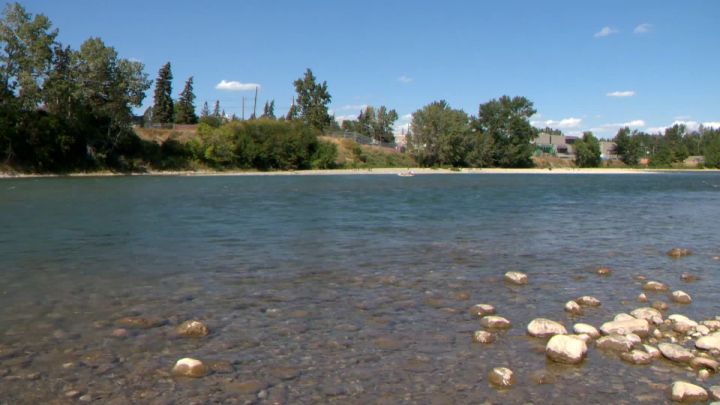Warm weather and “quite low flows” in some of Alberta’s waterways could soon prompt angling restrictions for southern and southwestern parts of the province, according to a biologist.

“We’ve been monitoring the flow and temperature situation and we found that after enjoying a pretty delayed snowpack melt and pretty high flows for a while, now we’re experiencing quite low flows and and elevated temperatures,” Paul Christensen, a senior fisheries biologist with Alberta Environment and Parks in Cochrane, told Global News on Wednesday.
“Warm water holds less oxygen, and that can cause physiological stress in fish when it creeps above a certain amount — depending on the type of fish you’re looking at. Most acutely, it can actually cause fish kills.”

Christensen said “hooking and fighting a fish” causes additional stress and the goal is to keep any disruption to fish populations to a minimum.
READ MORE: Alberta anglers fear stream closures coming, blame industry, recreation
While angling restrictions have not yet been announced, Christensen said that could happen as early as Saturday. If the restrictions are announced, he said they would take effect at 2 p.m. Saturday and likely remain in place until 11:59 p.m. on Aug. 31. The restrictions would still allow angling to take place each day, but not between 2 p.m. and midnight.
Christensen said if the restrictions are brought in, the waterways impacted would be in the Bow River East Slopes Fishery Management Zone 1 and the St Mary River below St. Mary Reservoir.
- Enter at your own risk: New home security camera aims paintballs at intruders
- High benzene levels detected near Ontario First Nation for weeks, residents report sickness
- Beijing orders Apple to pull WhatsApp, Threads from its China app store
- Boston Dynamics unveils ‘creepy’ new fully electric humanoid robot
“And it’s inclusive of the Bow River from Banff to Bassano,” he noted. “So that extends just slightly outside of Fisheries Zone ES 1.”
READ MORE: Fishing regulations change at Bow River from Banff to Bassano
Christensen acknowledged that some anglers may wonder why all streams in that area could see restrictions.
“A big driver for this is about managing the high, anticipated shift of effort that would go from the Bow River to those streams,” he said. “Our thinking and some of our data show that if we were to close the Bow River, a lot of that effort would just shift to the East Slopes — and we have a lot of different species at risk and lower-density, higher-vulnerability fish populations in those areas.
“So if you can imagine all of the popularity of the Bow River angling effort, if it just migrated to a lot of those East Slope streams, that would add additional and significant pressure on those streams as well, and that’s something that we’d like to avoid.”
READ MORE: Rising water temperatures in Alberta rivers, lakes threatens aquatic life
Christensen said his government department tries to give people who earn a living through angling “a heads-up” on any developments.
“One thing that I’ve noticed is that the industry itself has adapted to some of these circumstances,” he said. “So I’d have to give a shout-out to them for willingly doing the right thing.
“What we’ve seen them do is say to their clients that they would like them to shift their angling activities to the morning, so a lot of those trips, you know, whether it’s for reasons of better catchability or better user experience, I think it’s actually quite driven by some of this recognition of impacts for fish. They have voluntarily moved some of these trips to times of day that don’t reflect that.”

Christensen said his department has taken a look at some trends in waterways over the past decade.
“We’re seeing that it’s manifesting itself differently in every other year,” he said. “This year, we actually thought we were in really great shape. You know, Sunshine Village (Ski Resort) was open for the Canada Day long weekend because of high snowpack. And we watched a lot of the snow pillows stay much, much longer than they have and water stayed really high until then.
“But now that we’ve had successive very hot days, those snowpacks have gone and the incoming flows in the Bow are low… at this point, it’s very difficult for us to predict when this thing would happen.”
READ MORE: Canadian lakes getting warmer and shallower amid climate change: study
Christensen noted that if restrictions are put in place, the goal will not be to “issue enforcement actions” but rather “reinforcing good behaviour.”
.
“But, you know, if there’s people that are continuing to not obey the rules, then it is a fishing regulation, just like any other fishing regulation that would be subject to some enforcement activities.”
READ MORE: Warmer waters from climate change expected to shrink fish: UBC researchers
Christensen noted that lower flows and warmer water is an issue that is “being experienced in a lot of different places in the world right now.”
–With files from Adam MacVicar, Global News




Comments